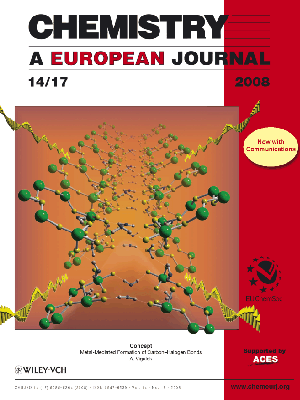Abstract of Publication No. 587
 Stefan T. Ochsenbein, Floriana Tuna, Marzio Rancan, Rachel S. G. Davies, Christopher A. Muryn,
Oliver Waldmann, Roland Bircher, Andreas Sieber, Graham Carver, Hannu Mutka, Felix Fernandez-Alonso,
Andrew Podlesnyak, Larry P. Engelhardt, Grigore A. Timco, Hans U. Güdel and Richard E. P. Winpenny
Stefan T. Ochsenbein, Floriana Tuna, Marzio Rancan, Rachel S. G. Davies, Christopher A. Muryn,
Oliver Waldmann, Roland Bircher, Andreas Sieber, Graham Carver, Hannu Mutka, Felix Fernandez-Alonso,
Andrew Podlesnyak, Larry P. Engelhardt, Grigore A. Timco, Hans U. Güdel and Richard E. P. Winpenny
Studies of Finite Molecular Chains: Synthesis, Structural, Magnetic and
Inelastic Neutron Scattering Studies of Hexa- and Heptanuclear Chromium Horseshoes
Chem. Eur. J. 14, 5144-5158 (2008)
![]()
![]()
![]()
![]()
![]()
Abstract:
We report the synthesis and structural characterisation of a family of finite
molecular chains, specifically [{[R2NH2]3[Cr6F11(O2CCMe3)10]}2]
(in which R=nPr 1, Et 2, nBu 3), [{Et2NH}2{[Et2NH2]3[Cr7F12(O2CCMe3)12][HO2CCMe3]2}2]
(4), [{[Me2NH2]3[Cr6F11(O2CCMe3)10]·2.5 H2O}4]
(5) and [{[iPr2NH2]3[Cr7F12(O2CCMe3)12]}2]
(6). The structures all contain horseshoes of chromium centres, with each
Cr···Cr
contact within the horseshoe bridged by a fluoride and two pivalates. The
horseshoes are linked through hydrogen bonds to the secondary ammonium cations
in the structure, leading to di- and tetra-horseshoe structures. Through
magnetic measurements and inelastic neutron scattering studies we have
determined the exchange coupling constants in 1 and 6. In 1
it is possible to distinguish two exchange interactions, JA=-1.1 meV
and JB=-1.4 meV; JA is the exchange
interactions at the tips of the horseshoe and JB is the
exchange within the body of the horseshoe (1 meV=8.066 cm-1). For
6 only one interaction was needed to model the data: J=-1.18 meV. The
single-ion anisotropy parameters for CrIII were also derived for the
two compounds as: for 1, DCr=-0.028 meV and |ECr|=0.005 meV;
for 6, DCr=-0.031 meV. Magnetic-field-dependent
inelastic neutron scattering experiments on 1 allowed the Zeeman
splitting of the first two excited states and level crossings to be observed.
For the tetramer of horseshoes (5), quantum Monte Carlo calculations were
used to fit the magnetic susceptibility behaviour, giving two exchange
interactions within the horseshoe (-1.32 and -1.65 meV) and a weak
inter-horseshoe coupling of +0.12 meV. Multi-frequency variable-temperature EPR
studies on 1, 2 and 6 have also been performed, allowing
further characterisation of the spin Hamiltonian parameters of these chains.
Cover Picture:
Molecular horseshoe magnets pack in crystals to give beautiful supramolecular arrays.
They can also be regarded as finite chains of paramagnetic ions, and, therefore,
can also be used to test models for magnetic behavior, such as spin-wave theory,
as H. U. Güdel, R. E. P. Winpenny et al. show
on page 5144 ff., in their Full Paper.